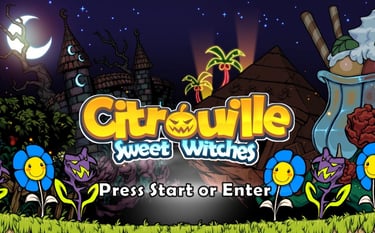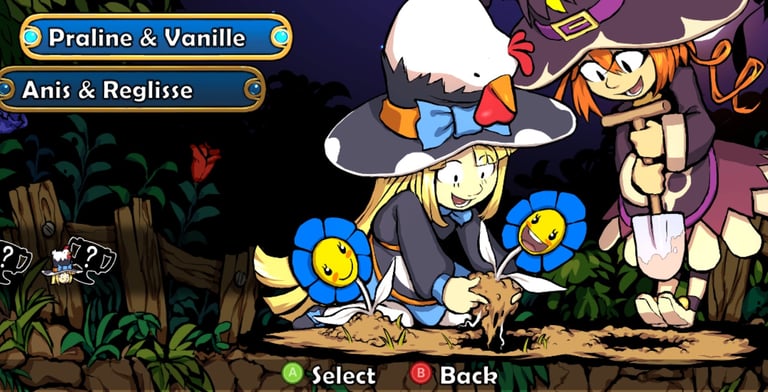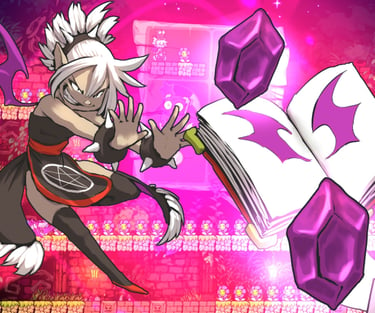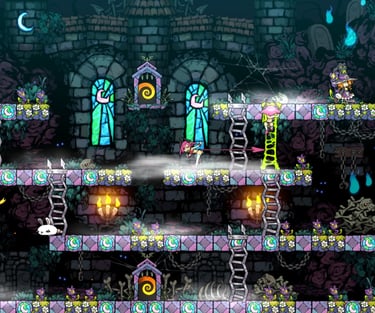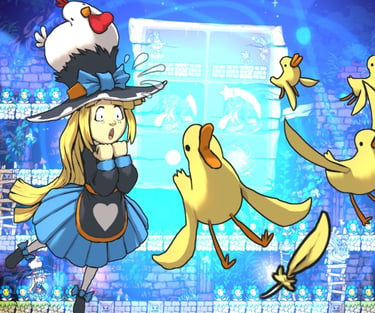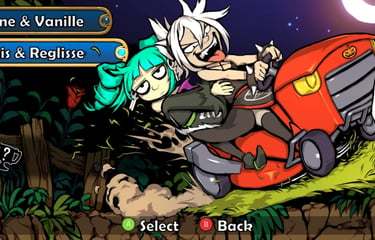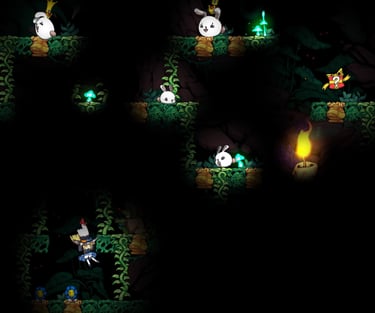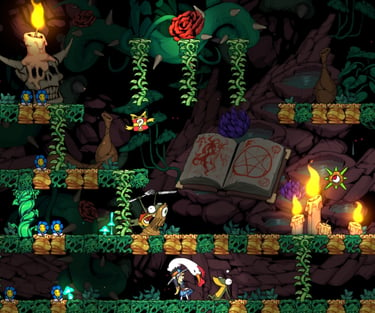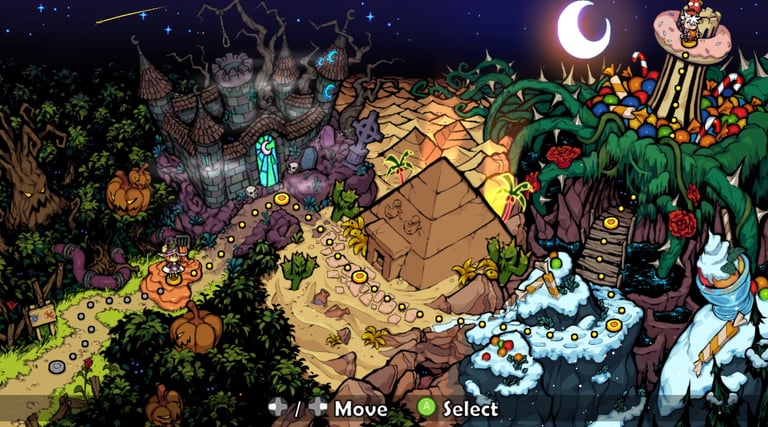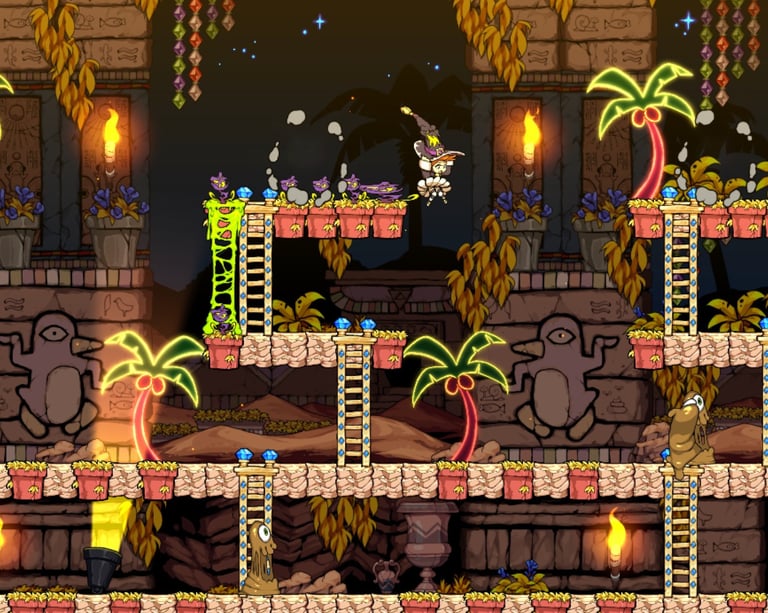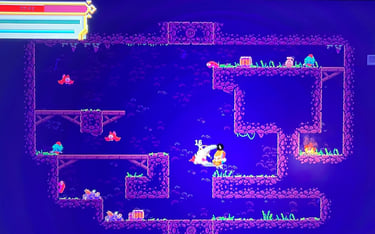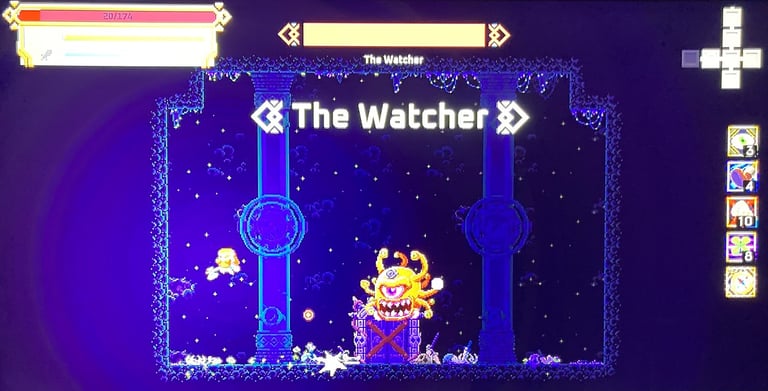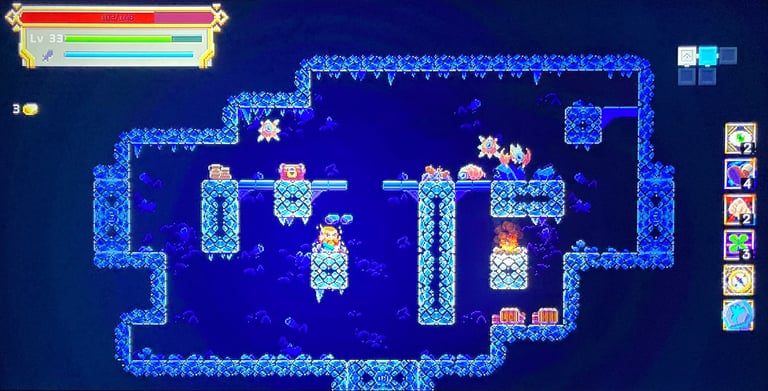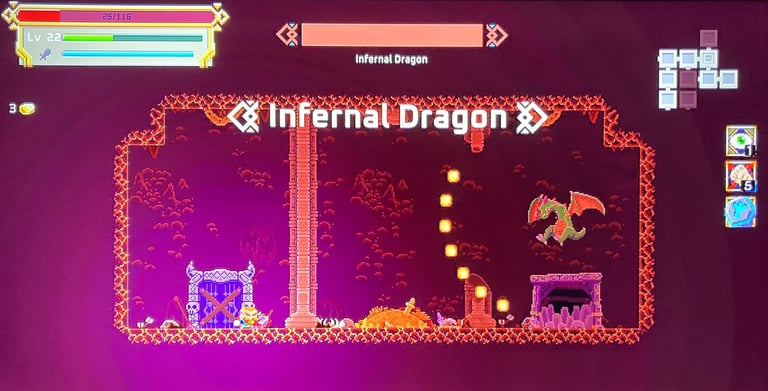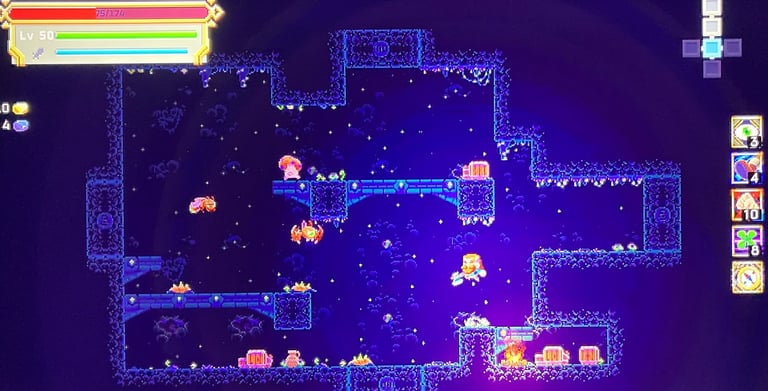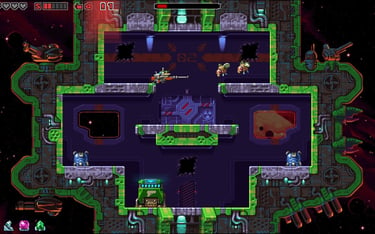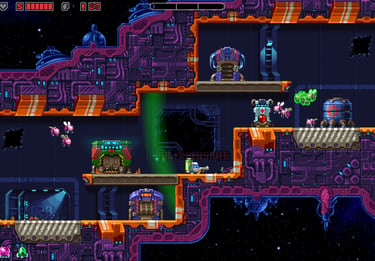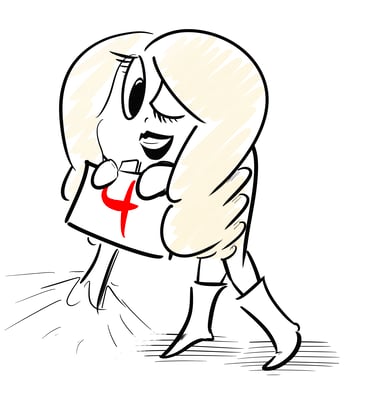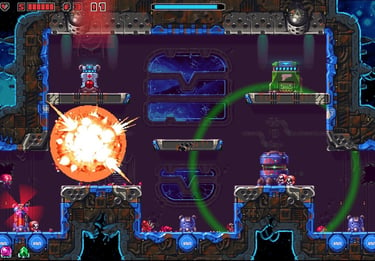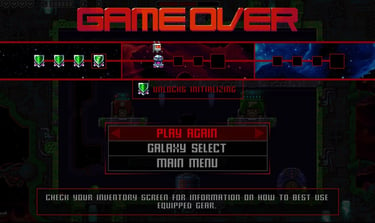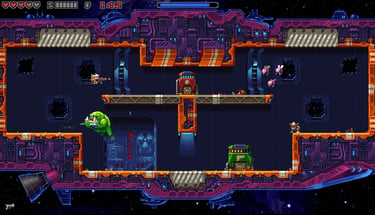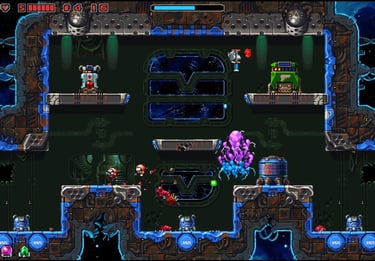Platform: Steam

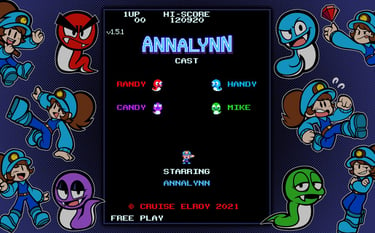

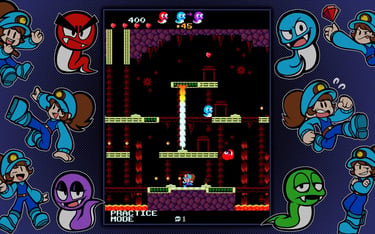
Gaming was different in the 1980s, marked more by surreal whimsy than the heavy-handed, often pretentious productions so prevalent in modern times. It was a time of munching pucks and encroaching ghosts. Of men inflating underground dragons, inexplicably, until they popped. Of knights mounting flying ostriches and, again inexplicably, going to war. It was an age of trippy creativity that modern gaming scarcely understands.
The creators behind Annalynn, then, must be blissfully unaware that times have changed, for they have produced here a perfect pastiche of 1980s gaming. At first glance, it’s an obvious ode to Pac-Man with its “chase-the-trinkets” gameplay, but one that trades the overhead view for a platformer more in the Donkey Kong or Mappy vein. Even its titular character, the plucky gold miner Annalynn, is a clear gender-swapped take on Fix-It Felix of Wreck-It Ralph fame. She’s cute and instantly likable, but also stands as the one blunt to the game’s otherwise flawless early ‘80s authenticity—protagonists of the era were usually squat, pudgy men, the product of limited resolution and processor power. She simply doesn’t fit the era’s archetype, for better or worse.
But no matter. The game is fast and fun, with the girl collecting gold nuggets across an assortment of treacherous stages, from woodland groves to catacombs of lava to even an archaeological dig-site. Levels are relatively small but scroll left and right, forcing the player to sometimes guess where the title’s four pursuing enemies—a gang of always chasing snakes—may be lurking. These creatures can duck in and out of doors inaccessible to the player, allowing them to “skip ahead,” maybe a little unfairly, to wherever the player is running. For her part, Annalynn can only run, jump and climb, bounding across platforms and scrambling up ropes to grab more gold and hopefully keep ahead of her pursuers. Fortunately, in true Pac-Man-style, special red gems are also in the mix, granting her momentary invincibility by which she can then oust the snakes in a sort of temporary revenge. But usually, it’s run or be munched.
And that, perhaps, is also the game’s greatest sin—the level design sometimes works too viciously against the player, making death almost inevitable as awkward jumps must be made, traps and dead-ends avoided, and snakes constantly dodged. The latter issue is the most serious; every stage is dominated with those deadly doors, making it all too easy for tailing serpents to suddenly “warp” forward and take the upper hand. Having to constantly anticipate their endless appearances becomes exhausting.
Fortunately, these kinks don’t substantially undermine an otherwise fine game—one that still comes wholeheartedly recommended. Maybe Cruise Elroy, the game’s chief architect, will grace fans with an improved sequel in the future.
Super Annalynn, anyone?--D
Developer: Cruise Elroy
Publisher: Cruise Elroy
Release Date: Jan. 29, 2021
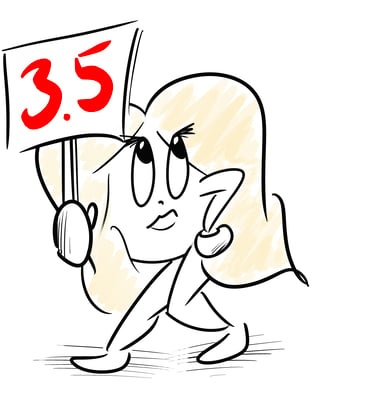

Asteroids: Recharged
Platform: Steam, PS4 (reviewed), Xbox Series X/S, Nintendo Switch

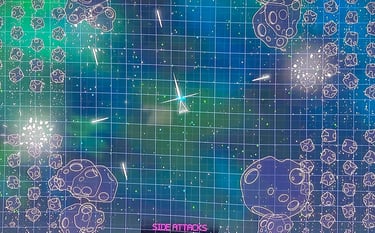
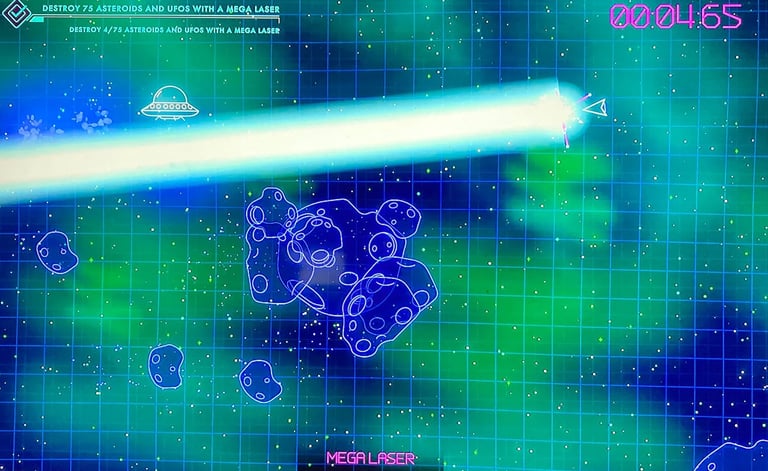

Atari is the company that constantly dies but never stays dead—an enterprise of perpetual ebb and flow, fading into the periphery before rising again with another initiative, anniversary collection, or franchise revival. And in terms of the latter, the latest is the “Recharged” series that brings back some of the company’s most storied classics with modern day upgrades and added twists. The titles themselves, despite being very distinct, all share the same neon, “recharged” aesthetic and pick-up-and-play sensibility. These are not complicated experiences, but remixed arcade games meant to test endurance and pure reflex.
And Asteroids certainly bears this direction, differing little from its 1979 counterpart. The player still guides a triangular ship across a wrapped screen, firing tiny bullets into a collage of much larger, free-floating rocks. These punctured boulders then break apart into smaller asteroids, which split into even smaller iterations when blasted again. The goal, then, is to obliterate all traces of these floating baubles without smashing into one. So-called UFOs of varying aggression also show on occasion, firing shots of unnerving accuracy upon the player. For good players, these enemies are the truest threat.
Nevertheless, the real challenge is in the controls, which rely on thrust and inertia for movement. Too much “gas” can fling the little rocket erratically around the screen, making defeat all but guaranteed. An emergency hyperspace function can be used to randomly warp oneself to safety, maybe…but the unpredictability of the maneuver rarely makes it a winning risk.
The game plays well but might disappoint those expecting anything radically new. Powerups offer the greatest change, enhancing the player’s gun with rapid fire, exploding bullets, seven-way spreads, and a number of other helpful accouterments. The added upgrades fade quickly, however, and appear erratically enough to ensure that progress remains decidedly precarious.
A new mission-mode is also included, giving players bite-sized objectives to complete. These are fun and infuse some needed life into an otherwise very simple and repetitive affair. Local co-op play rounds out the offerings for some two-player chaos, but a four-player mode could have been incredible.
Asteroids purists will appreciate the faithfully recreated gameplay and the faux-vector aesthetic that, at least for this game, seems appropriate. The music also enhances the package with some especially rhythmic, pulsing beats. But “faithful” basically means “safe” in this case, and there’s nothing here that feels particularly "recharged." Blasteroids, an Asteroids sequel from way back in 1987, offers gamers plenty more variety and depth, as does Activision’s remake from 1998. By comparison, this feels like an inconsequential, budget release.
And, at only ten dollars, so it is.--D
Developer: Adamvision Studios, SneakyBox
Publisher: Atari, Inc.
Release Date: Dec. 14, 2021


Black Widow: Recharged
Platform: Steam, PS4 (reviewed), Xbox Series X/S, Nintendo Switch
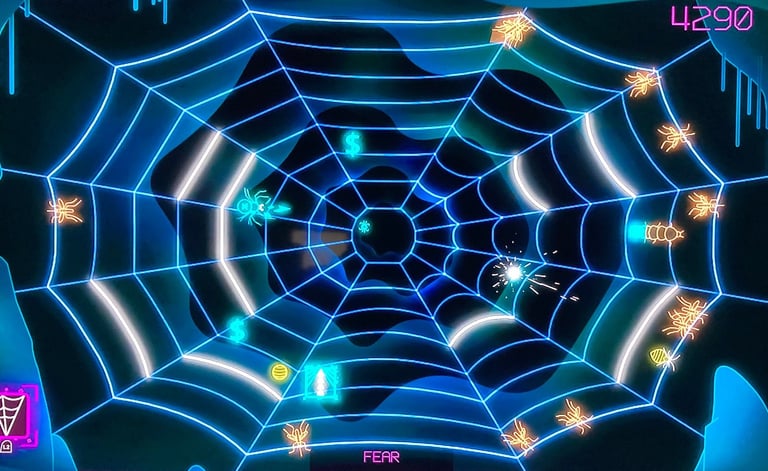


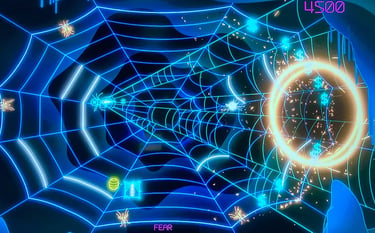
In keeping with most games of its era, the original 1982 Black Widow was a simple affair—blast the bugs as they come! Indeed, the oval-grid in which the player scurried his spider was a constant faucet of incoming threats as insects appeared from all sides. The game wasn’t anything groundbreaking, but at least the controls were unique—it was among the first (was the first?) to use a “twin-stick” control scheme in which one joystick moved the character while the other fired independently in any direction. This gave the proceedings a kind of desperate freneticism rarely seen at the time, rivaling the action of even Robotron 2084. Years later, Black Widow would be reconsidered by some as a kind of unfortunate, overlooked classic.
Black Widow Recharged attempts to duplicate the original’s excitement with an “if it ain’t broke, don’t fix it” philosophy. In other words, despite the obvious graphical and mechanical refinements, this is largely the same game that came before. Players are still blasting bugs as they struggle to stay alive amidst a vast spider web, collecting dropped dollar signs for points, and knocking eggs down the web’s shafts before they hatch. What is new to this version are the powerups, which bolster firepower for prolonged survival…if only for a fleeting span of time.
As in other Recharged titles, a mission mode is included to give players more to do. Objectives range from killing “…35 grenade bugs” to surviving “…for 60 seconds,” granting the title a more home console-oriented style-of-play while still preserving the arcade feel. Co-op play is also provided across both mission and normal options.
Black Widow’s greatest weakness is also its greatest benefit—the old school design is instantly fun, but that appeal dampens fast. Only those with a heart for score chasing will truly appreciate the game’s finer nuances—most will just blast some bugs, shrug, and move on.--D
Developer: Adamvision Studios, SneakyBox
Publisher: Atari, Inc.
Release Date: Oct. 28, 2021


Platform: Windows
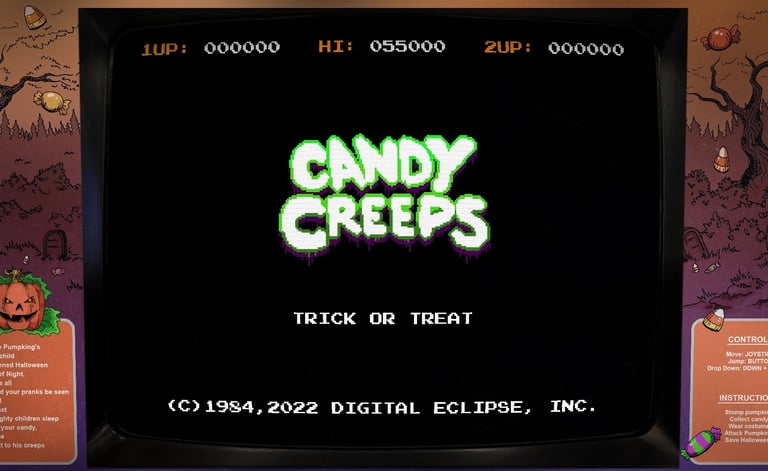

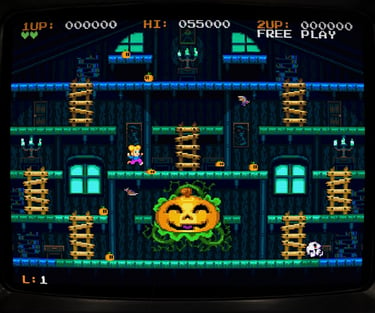

Level 1's the easiest. On the first go-round, it's only two obnoxious bats and a skull that cause problems.


Level 2 brings the cleaver. And the wrap-around screen means the mummies keep coming.
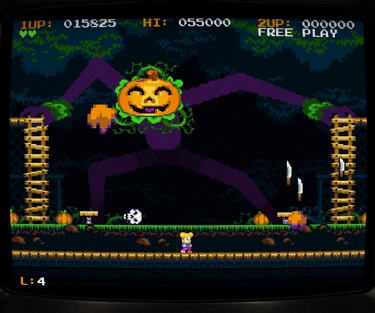

Level 4 is the denouement. Send those blades back into Pumpking's simpering face!

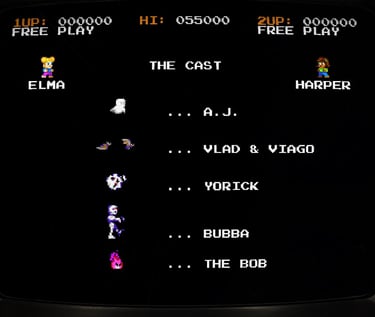
Elma and Harper are the heroines. No boys allowed, apparently.
Candy Creeps follows in the tradition of other single-screen, “new-retro” releases, recreating a faux-‘80s arcade experience all about survival and chasing high scores. It probably best resembles Donut Dodo, another modern single-screen platformer in which a little man must scurry after pastries littered across a squarish stage. But here, it’s not about a baker or cakes, but two girls snatching candy across four ghoul-filled levels.
Holding true to the classic mold, the story is more inferred than told; Creeps’ heroines must defeat the giant “Pumpking” by bopping atop the endless pumpkins he constantly spews. Smashing these scattering squashes sometimes yields a precious piece of candy; snarfing three of these will grant the girl a brief spree of increased strength and invincibility. Now the girls can attack the Master Pumpkin himself, jumping up and punching him from beneath until the grinning gourd explodes.
The first three levels follow these rules, changing only the dangers and obstacles to avoid. The first has bats, the second is fissured by a gigantic, swinging scythe, and the third is beset by conveyors and chasing flame. In all three, the Pumpkin King’s kin bounce and bobble everywhere—although not directly harmful, they tend to bump and nudge the player into other dangers. The Pumpkin King himself is also no pushover, taking repeated attacks to defeat while packing some formidable defenses. Those three candy pieces might have to be grabbed several times over.
The fourth stage swaps the formula for what’s essentially a climactic boss battle. With the King swinging overhead, players must dodge his pouncing carving knives while, when possible, smacking them back with a timely jump. But even victory brings only a brief reprieve before the entire four-stage gauntlet begins again at a higher difficulty.
As much an homage to Halloween as it is to the old-school platformer, Candy Creeps is an attractive package of thematic graphics and a peppy, mischievous score. It also provides an inspired alternative to the “reach the top” or “defeat them all” prerogatives that usually dominate the genre. But clever mechanics don’t always equal “good,” and Creeps’ floaty, pinball-bouncy physics grants the game an imprecise, almost erratic feel that’s ill-suited to the category. Fifteen baby pumpkins all repelling the player in different directions equates to a glut of frustrating deaths in a way tighter platformers—like Donut Dodo—intuitively avoid. In other words, the player never feels he has full control over, well, the controls.
Nevertheless, the game is an interesting bit of historical “What If” fiction, a peek into an alternate time in which the genre never died. But, perhaps, that’s also the problem—the category needs a revival, not just a tribute. Candy Creeps is sweet but not especially compelling, a Tootsie Roll when one was craving a Snickers.--D
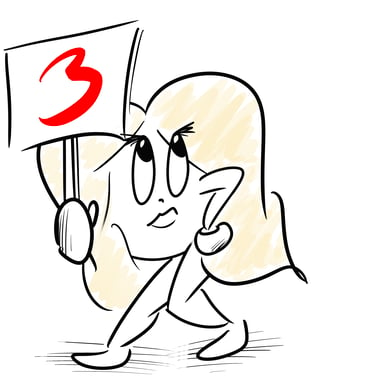

Publisher: itch.io
Developer: Digital Eclipse
Release: Oct. 27, 2022
Genre: Single-screen Platformer
Pac-Man Museum +
Platform: Xbox Series S/X (reviewed), PS4/5, Nintendo Switch

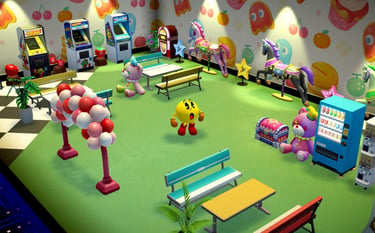
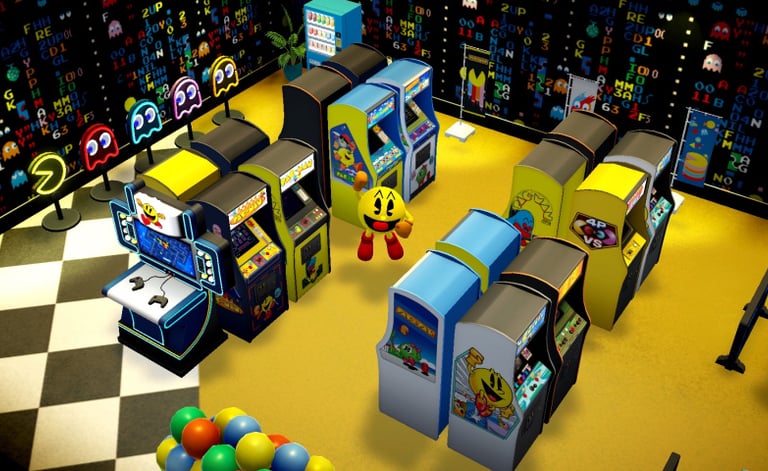

Pac-Man Museum + offers, maybe oddly, not a museum to personalize, but a Pac-Themed arcade. As seen, a number of aesthetics are possible.
Pac is back in another collection, this one boasting 14 games spread across the hero's 40+ year career. The games are what most would expect, from the original classic to some late-80s/early-90s oddities (Pac-Attack, Pac-in-Time) to the renaissance years of the past two decades (Pac-Man Championship Edition, Pac-Man 256). Everything comes pac-kaged (ha!) in a nice presentation that allows players to recreate their own old-school arcade as they continue to unlock and earn more of the collection's games and additional trinkets.
There are problems, however. The input lag (delay between a button press and the response seen on-screen) for most of these games is atrocious, with a handful being nearly unplayable. Pac-in-Time seems the hardest hit, with the already-clumsy controls made all the worse due to sluggish inputs. Other games, like Championship Edition, handle so squirrely, the level of lag is harder to pinpoint, although climbing the leaderboards seemed harder than before in this particular version.
Perhaps equally disappointing, however, is the lack of historical documentation or memorabilia that would have both taught and celebrated the yella fella's heritage. Why not have clips from the old cartoon shows, interviews with Toru Iwatani (Pac's creator), a pac-parade of just some of the mascot's many decades of merchandise, and even an option to toggle between the games' many regional variants? For instance, Pac-Land had Chomp Chomp the Dog and Sourpuss the Cat in the American version, and the American cabinet artwork for Super Pac-Man is completely different from the Japanese build...yet it's the foreign version Namco has chosen to include here. Furthermore, titles like the beloved Pac-Man World and the (somewhat) admired Pac-Man 2: The New Adventures are nowhere to be found, a huge omission for what's supposed to be a "museum." And yes, Ms. Pac-Man has been apparently divorced from the series, as well. (Hello, uh, Pac-Mom...)
IPs and licensing rights, likely, are the cause for some of these exclusions. But this still means a collection that, although worthwhile at the admittedly reasonable price-point, is still woefully incomplete. One can only dream that, someday, Namco Bandai will finally deliver the quintessential collection that has everything, from Pac-Man World Rally and Pac-Pix to Pac-Man Championship Edition DX to even the weird Midway hacks of the early '80s, like Jr. Pac-Man and Pac-Man Plus.
Until then, we have this, a half-baked, half-packed (ha?) compilation that feels like a rushed cash-grab. But, for twenty bucks? One can still do a whole lot worse (and seeing 1996's Pac-Man Arrangement offered here along with the fun multiplayer frenzy that is Pac-Man: Battle Royale almost makes up for the other disappointments).
Thank you, Namco, but do better. Perhaps in Pac-Man Museum 2030?--D
Thanks to www.xboxachievements.com and www.bleedingcool.com for the pics!

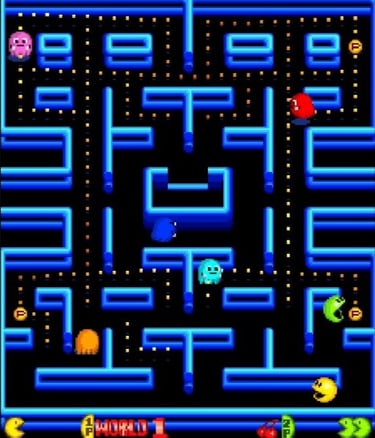
1996's Pac-Man Arrangement is still an overlooked treasure that is happily included in the collection. Cute graphics, fast gameplay, and a neat co-op mode make this one a must-play.
Developer: Bandai-Namco
Publisher: Bandai-Namco
Release Date: May 27, 2022
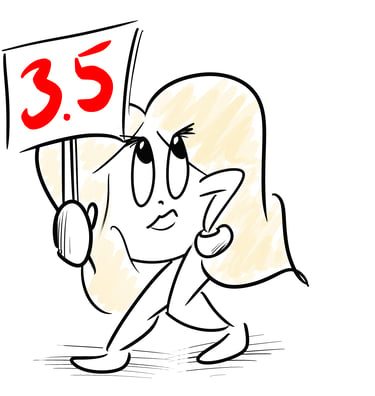

Wonder Boy Returns Remix
Platform: Steam (reviewed), PS4/5, Nintendo Switch
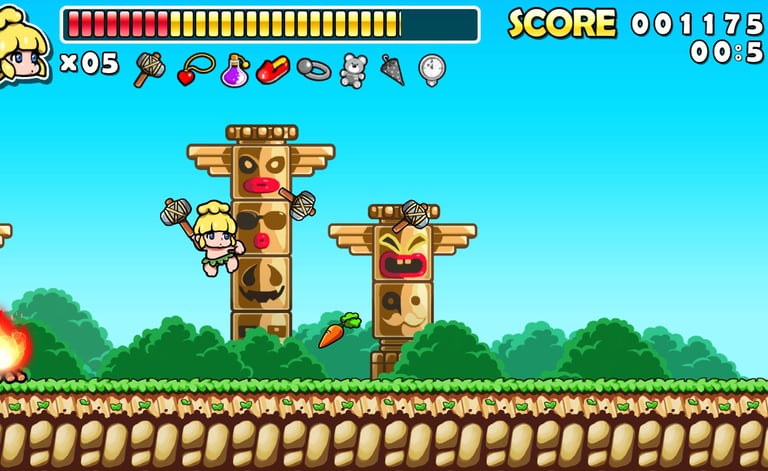



Along with the stone axes, Tom Tom can snag a skateboard (turning the game into a true auto-runner) and an invincibility-granting cherub of sorts.
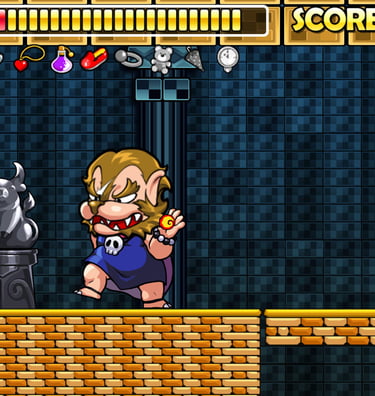

A boss appears at the end of every fourth stage. They all fight similarly, however, much like the repeating Bowser fights in Super Mario Bros. were largely cut-and-paste jobs with minimal differences.
The Wonder Boy/Monster World series has a storied and somewhat convoluted past, beginning as Wonder Boy, a humble platformer from 1986, and evolving into the full action-adventure Monster World 4 by the franchise’s finale in the mid-90s. In fact, the first game is better known as Hudson’s Adventure Island in the West—it’s essentially the same title, just reskinned and repurposed with Hudson Soft characters.
The franchise proved popular but fell dormant at the cusp of the 32-bit age, resurfacing only recently as 2016’s Wonder Boy Returns. Something of a reimagined, prettier remix of the 1986 hit, it received only a tepid reaction from the press. Chintzy graphics, quirky controls, odd glitches, and bland level design were among the more egregious criticisms. The reception was considered so negative, in fact, the developer delisted the game in 2019.
Hence Wonder Boy: Returns Remix, a redo that ironically unmixes the previous remix, providing a game that’s now a safer, truer remake of the 1986 classic with only minor refinements (but which retains the same graphical facelift). Where Returns tried to refresh the formula with reworked level designs and brand new bosses, Remix doesn’t actually remix or reimagine anything—it simply duplicates the old 8-bit level designs with some modern sensibilities. Which, in essence, amounts to a lot of running and jumping.
Indeed, Wonder Boy is the prototypal auto-runner; Tom Tom, the game’s boyish protagonist, is burdened with a quickly diminishing health bar that can only be replenished by snatching fruit. This means rushing through each of the game’s 32 levels, leaping holes and attacking enemies while snatching treats as they appear. It’s really a race against death, a speed-running gauntlet to the end before Tom Tom’s lifeline expires. Stopping too much or too long brings certain doom.
And Remix duplicates this template, offering the same fast and frantic fun that, unfortunately or not, will be very familiar to longtime players. These fans will have to decide what makes the better treasure: a new game that reimagines the classic mechanics to the point of detriment (Returns), or a straight remake that sacrifices creativity for competency (Remix). The former’s complete and sweeping delistment, of course, makes the choice a regrettable moot point either way.
Fortunately, this new iteration of Wonder Boy sees just enough improvement to make it, if not the most quintessential version, then perhaps the most definitive. Tom Tom’s movements flow with greater fluidity than before. His primary attack—tossing stone hatchets—unfurl with increased zest and rapidity. And his girlfriend, the otherwise captive Tanya, is a fun, playable alternative thanks to her boomerang flinging abilities. The music is also upbeat and fitting. Only the graphics lightly disappoint, using the same saturated, homogenized style that gave Returns such a cheap, budget feeling.
Some Wonder Boy revivals and remakes are more worthwhile than others; Wonder Boy: The Dragon’s Trap, Monster Boy and the Cursed Kingdom, and Wonder Boy: Asha in Monster World comprise the right balance of contemporary versus classic sensibilities. Compared to these, Wonder Boy: Returns Remix is an opportunity missed, a game that feels more akin to a fond farewell than, well, a return to form.
It might keep the faithful satiated, but newcomers will be left wondering the obvious: Was Wonder Boy really ever that wonderful?--D


Ryuichi Nishizawa is the creator of the Wonder Boy franchise. In keeping with the original game's "auto-runner" feel, the master admits, "The initial game concept for Wonder Boy was designed to have the main character keep running and not be able to stop...However, when I implemented this specification, I found that the game was more difficult than I had imagined and was not for everyone, but I wanted to keep that tension..." Thus, as a sort of compromise, he developed the ever-diminishing health bar. It allowed players to stop if necessary, but at the cost of precious energy. Freezing in place was a sort of last resort, keeping both the frenetic stress and platforming finesse intact.
(Thanks to Retro Gamer Magazine #235 for this handy fact!)
Developer: CFK Co., Ltd.
Publisher: CFK Co., Ltd.
Release Date: May 23, 2019




